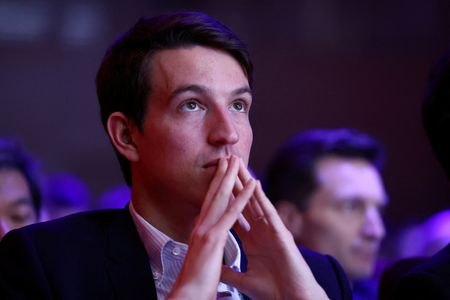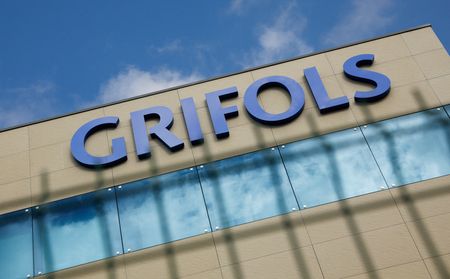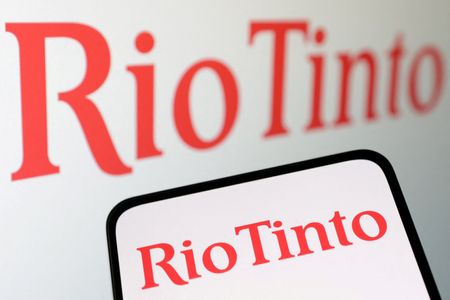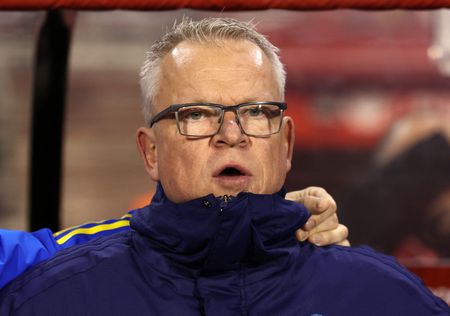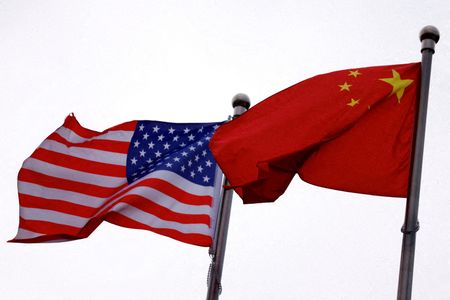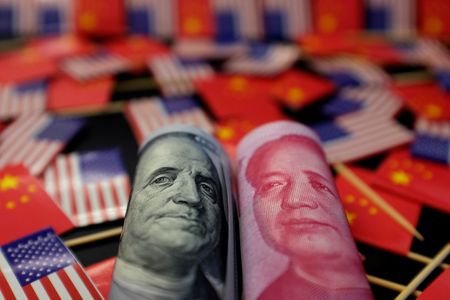By Mimosa Spencer and Tassilo Hummel
PARIS (Reuters) – Bernard Arnault’s son Alexandre has been handed a daunting task: reviving LVMH’s worst-performing unit, the famed Moet Hennessy drinks business, in the midst of a tariff war.
If successful, the 33-year old could gain a leg up in the closely watched succession contest among five siblings to lead the $280 billion luxury conglomerate headed by his father.
On Tuesday, Alexandre accompanied his father to Washington, where they attended the swearing-in of Middle East envoy Steve Witkoff, broadcast on local channel Fox 5.
U.S. President Donald Trump, who greeted the pair among others at the White House, was heard in the broadcast referring to the younger Arnault as “the future” and a later meeting with them.
LVMH declined to comment on the meeting.
All five Arnault children hold management roles in the luxury empire which spans over 70 brands including fashion label Dior and jeweller Tiffany, though their 76-year-old father remains hands-on and has shown no sign of stepping down.
Delphine, 50, is CEO of Dior, while Antoine, 47, is head of group communications. Frederic, 30, recently took up the role of CEO of Loro Piana and Jean, 26, heads marketing for Louis Vuitton’s watches business.
Alexandre, the third sibling, previously held a senior role at U.S. jeweller Tiffany, joining Moet Hennessy in February as deputy to new CEO Jean-Jacques Guiony, a trusted adviser to Bernard who was LVMH’s finance chief for two decades.
The asset-light division, which sells drinks through third-party distributors and whose initials make up half the LVMH name, has traditionally served as a cash generator for the group, generating nearly $6 billion in turnover in 2024.
But last year, as demand in both the U.S. and China sagged, sales fell for the second consecutive year, while operating profit shrank by one-third.
Since champagne and cognac can only be produced in the eponymous French regions, they are subject to U.S. tariffs on imports from the European Union, currently fixed at 10% but due to rise to 20% in July. Trump has threatened much higher tariffs of as much as 200% should the EU go ahead with plans to tax bourbon whiskey in an escalating trade dispute.
Reinvigorating the business will require both diplomatic and business acumen.
“The true test as a manager is how you manage events through tough times,” said Markus Hansen, portfolio manager at Swiss bank Vontobel, adding that it would be hard to replicate the success of Bernard Arnault.
WEALTHY CLIENTS
In their first big internal announcement, Guiony and Alexandre said on April 30 they would cut staff at Moet Hennessy by 13% and concentrate marketing budgets on their biggest global labels, according to a video address seen by Reuters.
Alexandre told employees the situation was “very difficult”.
“Their message seems to be candid,” said Frederic Merceron, labour representative for the Force Ouvriere union, adding that staff were still waiting to hear about concrete proposals to reignite sales.
Alexandre also told staff last week he would personally oversee one of the shrinking division’s key assets: the Moet Hennessy Private unit that caters for the wealthiest clientele.
The unit, which has around 80 employees, offers exclusive experiences and personalized spirits blends for the ultra-rich. It famously sold a cask of Ardbeg Scotch for 16 million pounds in 2022 to a private investor in Asia.
“We’ve decided to take this business unit… and make it its own entity, reporting to me directly,” Arnault said, according to the video.
The emphasis on high-end customers might help moderate the wider impact of tariff threats and flagging consumer demand that is causing the slowest luxury industry growth in a decade.
Moet Hennessy’s larger base of middle-class clients, however, might be reluctant to splash out on a bottle of Moet if the price creeps above current levels of $50 or $60 per bottle because of tariffs, said HSBC analyst Anne-Laure Bismuth.
HIDDEN VALUE?
A steady stream of profit from Moet Hennessy, which merged with Louis Vuitton in 1987, for years helped fund Bernard Arnault’s acquisitions of brands including watchmaker Hublot and jewellery label Bulgari, and the opening of new stores.
Drawing on centuries-old winemaking techniques to sell products like Hennessy XO cognac, known for its curved bottles, and yellow-labeled Veuve Clicquot champagne, the division provided over 40% of group operating profit in the 1990s.
“This unit has been structural for the family, and has enabled the development of the group,” said Mathieu Devers, a representative from the CGT union at Hennessy, employed in the Cognac region.
While symbolically important to LVMH, which used the Moet & Chandon label in prestigious sponsorship deals for Formula 1 car racing and the Paris 2024 Olympics, the division’s economic contribution to the group has diminished.
Wines and spirits last year accounted for just 6% of group operating profit, down from around 20% in 2015, according to figures from Bernstein analysts.
If spun off, the division could be valued at 14 billion euros ($15.8 billion) once restructured, according to HSBC estimates.
Bernard Arnault, who famously tends to cling to his assets, has, however, dismissed the idea: “Divestment is not on the agenda,” he said in January.
HSBC says a sharper focus on “pure luxury” products such as fashion, leather, watches and jewellery would give LVMH a “tighter, more coherent portfolio that the market might value more highly”.
For Alexandre and Guiony, the clock is ticking.
“Let’s give them two years to show what they can do,” Bernard Arnault said after they took up their posts.
($1 = 0.8886 euros)
(This story has been corrected to fix the spelling of fifth child’s name in paragraph 7)
(Reporting by Mimosa Spencer, Tassilo Hummel and Dominique Patton, Editing by Lisa Jucca and Elaine Hardcastle)

